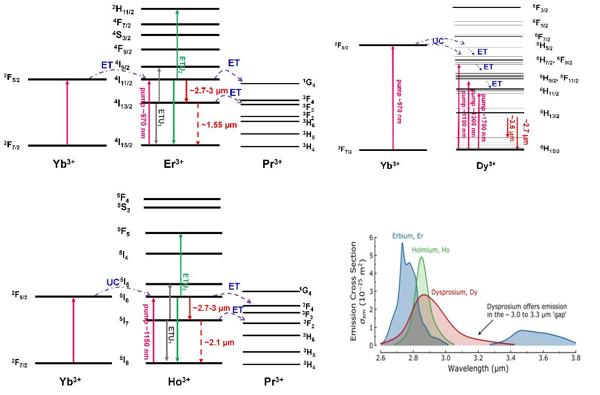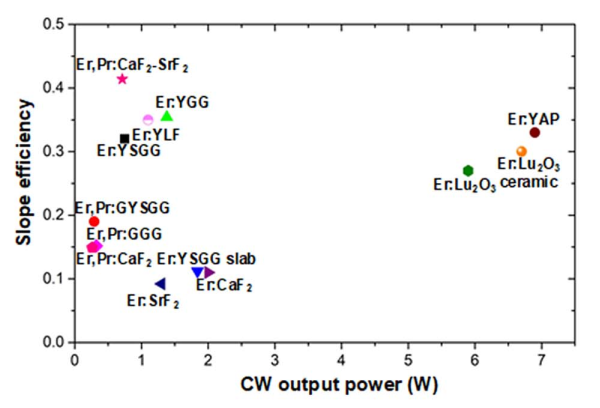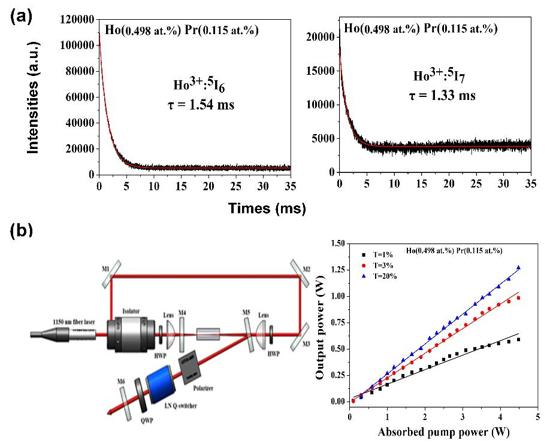Mid-infrared (MIR) laser sources operating in 2.7-3 µm spectral region have attracted extensive attention for many applications due to the unique features of locating at the atmospheric transparency window, corresponding to the "characteristic fingerprint" spectra of several gas molecules, and strong absorption of water. Up to now, the most advanced MIR solid-state laser technologies that used for 2.7-3 µm laser generation including but not limited the rare-earth doped crystalline and fiber lasers, the semiconductor laser diodes (LDs), the quantum cascade lasers (QCLs), and nonlinear optical frequency conversion {optical difference frequency generation (DFG), optical parametric sources [OPSs, including optical parametric oscillators (OPOs) , optical parametric generators (OPGs)], etc.}, and so on. Over the past two decades, significant developments have been achieved in 2.7-3 µm MIR lasers benefiting from the sustainable innovations in laser technology and the great progress in material science. Laser transition of Er3+: 4I11/2→4I13/2, Ho3+: 5I6→5I7 and Dy3+: 6H13/2 → 6H15/2 can emit wavelength at 2.7-3 µm spectral region [1], and thus are the mostly studied MIR bulk lasers.

Fig. 1 The simplified energy-level diagram of Er3+-, Ho3+- and Dy3+-doped crystals and typical emission spectrum [1]
Prof. Baitao Zhang and Jingliang He's group from Shandong University summarize and review the recent progress of MIR bulk laser sources based on the rare-earth ions-doped crystals at 2.7-3 µm spectral region, including Er3+, Ho3+ and Dy3+ doped crystalline lasers. The outlooks and challenges for future development of rare-earth doped MIR bulk lasers are also discussed. Related content was published in Chinese Optics Letters Volume 19, Issue 9 (Hongkun Nie, Baitao Zhang, and Jingliang He et al, Rare-earth ions-doped mid-infrared (2.7-3 µm) bulk lasers: a review [Invited]).
Easy growing and the pumping wavelength around ~970 nm (commercial LD operation wavelength) are the two fundamental merits that make Er3+-doped crystals to be much more extensively studied for 2.7-3 µm laser generation compared to that of Ho3+-and Dy3+-doped crystals. However, for Er3+: 4I11/2→4I13/2 transition, there is a so-called self-terminated effect leading to population bottleneck issue caused by the life time of upper laser level (4I11/2) much shorter than that of lower level (4I13/2), which is the main obstacle that prevents the development of Er3+doped 2.7-3 µm crystalline lasers. Increasing the doping concentration of Er3+ ion to generate "quenching effect" and co-doping with sensitized ions (Yb3+) with efficient population of Er3+:4I11/2 or deactivated ions (Pr3+) with efficient depopulation of Er3+:4I13/2 are the two main approaches to solve this detrimental feature [2, 3]. Fig. 2 shows the room temperature CW output power and the corresponding slope efficiency ever obtained with Er3+ ions-doped crystalline lasers in 2.7-3 µm region. The highest CW output power generated from Er3+-doped solid-state lasers at room temperature is 6.9 W [4], while the largest slope efficiency is 41.4% [5]. In the pulsed regime, flash-side-pumping is an effective and commonly used architecture to produce high energy 2.7-3 μm laser pulses at low repetition rate. Combined with LGS EO modulator, the highest pulse energy of 216 mJ and pulse width of 14.36 ns was obtained [6]. By using SESAM, Fe:ZnSe and novel 2D materials as saturable absorber, the passively Q-switched Er3+-doped crystalline lasers was realized [7-10].

Fig. 2 The summarization of the room temperature CW output power and slope efficiency of Er-doped crystalline lasers at 2.7-3 µm
Ho3+ ion is another promising candidate for generating 2.7-3 μm lasers related to 5I6→5I7 transition. However, Ho-doped crystalline lasers emitting in 2.7-3 μm spectral region are much less studied compared to that of emitting around ~2.1 μm and Er3+-doped lasers. The main limiting issues are the pumping wavelength around ~1150 nm and the same self-terminated effect occurring with Ho3+:5I6→5I7 transition (Ho3+:5I7 has a longer lifetime than Ho3+:5I6 resulting in the lower laser level during the oscillation). The same as Er3+:4I11/2→4I13/2 transition, the saturation of Ho3+:5I6→5I7 transition can also be suppressed by cascade lasing (Ho3+:5I6→5I7 and Ho3+:5I7→5I8 transitions) or co-doping with sensitized (Yb3+) or deactivated ions (Nd3+ and Pr3+). In 2019, by optimizing the doping concentration of Ho3+ and Pr3+ ions in Ho,Pr:YLF crystal, the lifetime of Ho3+:5I6 was designed to be larger than that of Ho3+:5I7, as shown in Fig. 3(a) [11]. By using the dual-end-pumping configuration, a maximum output power of 1.46 W was obtained with a slope efficiency of 7.7%, which is the largest CW output power ever obtained with Ho-doped crystalline lasers [12, 13]. A pulse energy as high as 41 mJ was obtained with flash lamp pumped (Ho,Nd): Y3Al5O12 laser [14]. Besides, the passive Q-switching laser operation with Ho3+ ion-doped crystals have been demonstrated with 2D materials as saturable absorber.

Fig. 3 (a)The fluorescence life time "reversion" of Ho:5I6 and Ho:5I7 in Ho,Pr:YLF crystal with doping concentrations of 0.498 and 0.115 at. % for Ho3+ and Pr3+ ions; (b) the experimental setup and laser output power of dual-end pumped EO Q-switched Ho,Pr:YLF laser[11]
Dy3+ ion is also a most promising and efficient candidate for emitting MIR laser wavelength around ~3 μm based on its energy level structure with Dy3+:6H13/2 → 6H15/2 transition. The study of Dy3+-doped MIR lasers is much less than that of Er3+ and Ho3+ ions, basically because of lack of high-quality crystal and pump source. It is excited that an efficiency 3.04 μm Dy:ZBLAN fiber laser was realized with a record slope efficiency of 51% pumped by a 2.8 μm Er:ZBLAN laser [15]. However, there is no reports about Dy3+ ion-doped MIR crystalline lasers.
In this review, we mainly summarize the state-of-art development of all solid-state MIR crystalline lasers in 2.7-3 μm spectral region based on Er3+, Ho3+ and Dy3+ doped crystals. However, there are still several challenges and a series of potential studies need to be further pursued in future. First, the host material selection and the preparation of the high-quality crystals are the basis for high power and high-efficient solid-state MIR crystalline lasers in 2.7-3 μm. Second, the selection of sensitized and deactivated ions and the doping concentration are also important for rear-earth doped crystalline lasers in 2.7-3 μm. Third, cascade laser operation is very attractive for multi-wavelength MIR laser generation. Fourth, the mode-locked laser operation is another challenge for rear-earth doped crystalline lasers in 2.7-3 μm.


